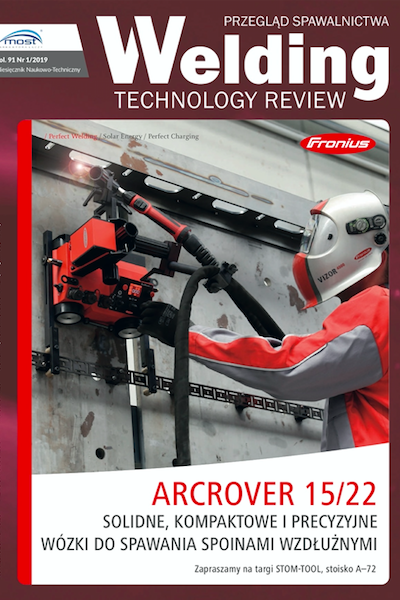The influence of the welding environment on the properties of Tekken joints made from S355J2C+N steel
##plugins.themes.bootstrap3.article.main##
Abstrakt
There are three main methods of underwater welding: dry, wet and intermediate between them, by using the local dry chamber. Due to low costs, the most common method is the wet welding with the use of covered electrodes. Water as a welding environment carries out a lot of problems. The first is limited visibility and instability of the welding arc. The biggest problem during underwater welding is high susceptibility to cold cracking, resulting from the increased diffusible hydrogen content in deposited metal and high stress values.
In the work, Tekken joints from S355J2C+N steel were made in air and in water environment. The joints were subjected to non-destructive visual (VT) and penetrant (PT) tests. Then, macroscopic tests and hardness measurements were performed. The results confirm the literature reports that the water environment causes an in-crease in hardness in the heat affected zone (HAZ), which promotes the formation of cracks in welding joints.
Pobrania
##plugins.themes.bootstrap3.article.details##
Creative Commons CC BY 4.0 https://creativecommons.org/licenses/by/4.0/
Artykuły czasopisma Welding Technology Review (Przegląd Spawalnictwa) publikowane są w otwartym dostępie na licencji CC BY (licencja Creative Commons Uznanie autorstwa 4.0 Międzynarodowe). Licencja CC BY jest najbardziej otwartą dostępną licencją i uważaną za „złoty standard” w formule otwartego dostępu; jest również preferowany przez wielu fundatorów badań. Licencja ta umożliwia czytelnikom kopiowanie i redystrybucję materiału na dowolnym nośniku i w dowolnym formacie, a także zmienianie, przekształcanie lub budowanie na nim materiału, w tym do użytku komercyjnego, pod warunkiem wskazania oryginalnego autora.
Bibliografia
J. Tomków, J. Łabanowski, D. Fydrych, G. Rogalski, Cold cracking of S460N steel in water environment, Polish Maritime Research (2018), 3(99), 131-136. DOI: https://doi.org/10.2478/pomr-2018-0104
G. Rogalski, J. Łabanowski, D. Fydrych, J. Tomków, Bead-on-plate welding of S235JR steel by underwater local dry chambet proces, Polish Maritime Research (2014), 21, 58-64. DOI: https://doi.org/10.2478/pomr-2014-0020
Y. Hu, YH. Shi, XQ. Shen, ZM. Wang, Microstructore, pitting corrosion resistance and impact toughness of duplex stainless steel underwater dry hyperbaric flux-cored arc. Materials (2008), vol. 10(12), 1443.
D. Purnama, W. Winarto, F. G. Susilo, Mechanical properties of underwater wet welded marine steel plates using different low hydrogen electrodes, AIP Conference Proceedings 1977, 030015, (2018), 1-5. DOI: https://doi.org/10.1063/1.5042935
W. B. Gao, D. Wang, F. Cheng, X. Di, W. Xu, Mictostructural and mechanical performance of underwater wet welded S355 steel, Journal of Materials Processing Technolony (2016), 238, 333-340. DOI: https://doi.org/10.1016/j.jmatprotec.2016.07.039
N. Guo, D. Liu, W. Guo, J. Feng, Effect of Ni on microstructure and mechanical properties of underwater wet welding joint, Materials&Design (2015), 77, 25-31. DOI: https://doi.org/10.1016/j.matdes.2015.04.007
W. B. Gao, D. P. Wang, F. J. Cheng, C. Y. Deng, W. Xu, Underwater wet welding for HSLA steels: chemical composition, defects, microstructures, and mechanical properties, Acta Metallurgica Sinica (English Letters) (2015), 9, 1097-1108.
J. Tomków, G. Rogalski, D. Fydrych, J. Łabanowski, Improvement of S355G1+N steel weldability in water environment by Temper Bead Welding. Journal of Materials Processing Technology (2018), 262, 372-381. DOI: https://doi.org/10.1016/j.jmatprotec.2018.06.034
H. Li, D. Liu, Y. Song, Y. Yan, N. Guo, J. Feng, Microstructure and mechanical properties of underwater wet welded high-carbon-equivalent steel Q460 using austenitic consumables, Journal of Materials Processing Technology (2017), 249, 149-157. DOI: https://doi.org/10.1016/j.jmatprotec.2017.06.009
D. Fydrych, J. Tomków, G. Rogalski, J. Łabanowski, Weldability of S460ML high strength low alloy steel in underwater conditions, Applied Mechanics and Materials (2016), 838, 10-17. DOI: https://doi.org/10.4028/www.scientific.net/AMM.838.10
A. Świerczyńska, D. Fydrych, G. Rogalski, Diffusible hydrogen management in underwater wet self-shielded flux cored arc welding, Internarional Journal of Hydrogen Energy (2017), vol. 42(38), 24532-24540.
J. Wang, Q. Sun, S. Zhang, C. Wang, L. Wu, J. Feng, Characterization of underwater welding arc bubble through a visual sensing method, Journal of Materials Processing Technology (2018), 251, 95-109.
D. Fydrych, G. Rogalski, J. Tomków, J. Łabanowski, Skłonność do tworzenia pęknięć zimnych złączy ze stali S420G2+M spawanej pod wodą metodą mokrą, Welding Technology Review (2013), vol. 85(10), 65-71.
K. Pańcikiewicz, A. Zielińska-Lipiec, L. Tuz, Ł. Rakoczy, Ocena skłonności do pęknięć zimnych złączy spawanych stali w próbie implantacyjnej, Welding Technology Review (2016), vol. 88(4), 63-65.
T. Schaupp, M. Rhode, H. Yahyaoui, T. Kannengiesser, Influence of heat control on hydrogen distribution in high-strength multi-layer welds with narrov groove, Welding in the World (2018), 1-10. DOI: https://doi.org/10.1007/s40194-018-00682-0
H. T. Zhang, X. Y. Dai, J. C. Feng, L. L. Hu, Preliminary investigation on real-time induction heating-assisted underwater wet welding, Welding Journal (2015), 1, 8-15.
Q. Sun, W. Cheng, Y. Liu, J. Wang, C. Cai, J. Feng, Microstructure and mechanical properities of ultrasonic assisted underwater wet welding joints. Materials & Design (2016), 103, 63-70. DOI: https://doi.org/10.1016/j.matdes.2016.04.019
J. Wang, Q. Sun, L. Wu, L. Liu, J. Teng, J. Feng, Effect of ultrasonic vibration on microstructural evolution and mechanical properties of underwater wet welding joint, Journal of Materials Processing Technology (2017), 246, 185-197. DOI: https://doi.org/10.1016/j.jmatprotec.2017.03.019
J. Wang, Q. Sun, S. Zhang, C. Wang, L. Wu, J. Feng, Characterization of the underwater welding arc bubble through a visual sensing method, Journal of Materials Processing Technology (2018), 251, 96-108. DOI: https://doi.org/10.1016/j.jmatprotec.2017.08.019
J. Tomków, D. Fydrych, G. Rogalski, J. Łabanowski, Temper bead welding od S460N steel in wet welding coiditions, Advances in Materials Science (2018), vol. 18(3), 5-14.
Katalog producenta elektrod Omnia, firmy Lincoln Electic.
